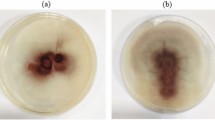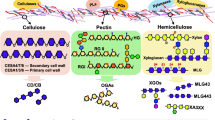Abstract
Maize is one of the more important agricultural crops in the world and, under certain conditions, prone to attack from pathogenic fungi. One of these, Aspergillus flavus, produces toxic and carcinogenic metabolites, called aflatoxins, as byproducts of its infection of maize kernels. The α-amylase of A. flavus is known to promote aflatoxin production in the endosperm of these infected kernels, and a 36-kDa protein from the Lablab purpureus, denoted AILP, has been shown to inhibit α-amylase production and the growth of A. flavus. Here, we report the isolation of six full-length labAI genes encoding AILP and a detailed analysis of the activities of the encoded proteins. Each of the six labAI genes encoded sequences of 274 amino acids, with the deduced amino acid sequences showing approximately 95–99% identity. The sequences are similar to those of lectin members of a legume lectin–arcelin–α-amylase inhibitor family reported to function in plant resistance to insect pests. The labAI genes did not show any of the structures characteristic of conserved structures identified in α-amylase inhibitors to date. The recombinant proteins of labAI-1 and labAI-2 agglutinated human red blood cells and inhibited A. flavus α-amylase in a manner similar to that shown by AILP. These data indicate that labAI genes are a new class of lectin members in legume seeds and that their proteins have both lectin and α-amylase inhibitor activity. These results are a valuable contribution to our knowledge of plant–pathogen interactions and will be applicable for developing protocols aimed at controlling A. flavus infection.





Similar content being viewed by others
Abbreviations
- α-AI:
-
α-Amylase inhibitor
- AIL:
-
α-Amylase inhibitor-like protein
- AILP:
-
α-Amylase inhibitor from Lablab purpureus
- AP:
-
Adaptor primer
- AOX:
-
Alcohol oxidase
- BMGY:
-
Buffered glycerol complex medium
- BMMY:
-
Buffered methanol complex medium
- GSP:
-
Gene-specific primer
- PHA:
-
Phytohemagglutinin
- TI:
-
Trypsin inhibitor
References
Ary MB, Richardson M, Shewry PR (1989) Purification and characterization of an insect α-amylase inhibitor/endochitinase from seeds of Job's Tears (Coix Lachryma-jobi). Biochem Biophys Acta 913:260–266
Bluhm BH, Woloshuk CP (2005) Amylopectin induces fumonisin B1 production by Fusatium verticillioides during colonization of maize kernels. Mol Plant Microbe Interact 18:1333–1339
Bompard-Gilles C, Rousseau P, Rouge P, Payan F (1996) Substrate mimicry in the active center of a mammalian α-amylase: structural analysis of an enzyme–inhibitor complex. Structure 4:1441–1452
Brown RL, Chen ZY, Cleveland TE, Cotty PJ, Cary JW (2001) Variation in the vitro alpha-amylase and protease activity is related to the virulence of Aspergillus flavus isolates. J Food Prot 64:401–404
Chen ZY, Brown RL, Lax AR, Cleveland TE, Russin JS (1999a) Inhibition of plant pathogenic fungi by a corn trypsin inhibitor overexpressed in Escherichia coli. Appl Environ Microbiol 65:1320–1324
Chen ZY, Brown RL, Russin JS, Lax AR, Cleveland TE (1999b) A corn trypsin inhibitor with antifungal activity inhibits Aspergillus flavus insect α-amylases. Phytopathology 89:902–907
Dohroo NP, Bhardwaj SS, Shyram KR (1987) Amylase and invertase activity as influenced by Pythium pleroticum causing rhizome rot of ginger. Plant Dis Res 2:106–107
Fakhoury AM, Woloshuk CP (1999) amy1, the α-amylase gene of Aspergillus flavus: involvement in aflatoxin biosynthesis in maize kernels. Phytopathology 89:908–914
Fakhoury AM, Woloshuk CP (2001) Inhibition of growth of Aspergillus flavus and fungal α-amylases by a lectin-like protein from Lablab purpureus. Mol Plant Microbe Interact 14:955–961
Finardi-Filho F, Mirkov TE, Chrispeels MJ (1996) A putative precursor protein in the evolution of the bean α-amylase inhibitor. Phytochemistry 43:57–62
Franco OL, Rigden DJ, Melo FR, Grossi-de-Sá MF, Chen ZY, Brown RL, Lax AR, Cleveland TE, Russin JS (2002) Plant inhibitors and their interaction with insect α-amylases: structure, function and potential for crop protection. Eur J Biochem 269:397–412
Le-Berre-Anton V, Nahoum V, Payan F, Rouge P (2000) Molecular basis for the specific binding of different α-amylase inhibitors from Phaseolus vulgaris seeds to the active site of α-amylase. Plant Physiol Biochem 38:657–665
Lee SH, Gepts PL, Whitaker JR (2002) Protein structure of common bean (Phaseolus vulgaris) α-amylase inhibitors. J Agric Food Chem 50:6618–6627
Leger RJ, Screen SE, Shams-Pirzaden B (2000) Lack of host specialized in Aspergillus flavus. Appl Environ Microbiol 66:320–324
Lioi L, Sparvoli F, Galasso I, Lanave C, Bollini R (2003) Leticn-related resistance factors against bruchids evolved through a number of duplication. Theor Appl Genet 107:814–822
Mirkov TE, Wahlstrom JM, Hagiwara K, Finardi-Filho F, Kjemtrup J, Chrispeels MJ (1994) Evolutionary relationships among proteins in the phytohemagglutination-arcelin-α-amylase inhibitor family of the common bean and its relatives. Plant Mol Biol 26:1103–1113
Moreno J, Chrispeels MJ (1989) A lectin gene encodes the α-amylase inhibitor of the common bean. Proc Natl Acad Sci USA 86:7885–7889
Morton RL, Schroeder HE, Bateman KS, Chrispeels MJ, Armstrong E (2000) Bean alpha-amylase inhibitor 1 in transgenic peas (Pisum sativum) provides complete protection from pea weevil (Bruchus pisorum) under field conditions. Proc Natl Acad Sci USA 97:3820–3825
Mourey L, Pedelacq JD, Fabre C, Causse H, Rouge P, Samama JP (1997) Small angle X-ray scattering and crystallographic studies of arcelin-1: an insecticidal lectin-like glycoprotein from Phaseolus vulgaris L. Proteins 29:433–442
Nagadhara D, Ramesh S, Pasalu IC, Rao YK, Krishnaiah NV, Sarma MP, Bown DP, Gatehouse JA, Reddy VD, Rao KV (2003) Transgenic India rice plants resistant to sap-sucking insects. Plant Biotechnol J 1:231–240
Nagadhara D, Ramesh S, Pasalu IC, Rao YK, Sarma NP, Reddy VD, Rao KV (2004) Tansgenic rice plants expressing the snowdrop lectin gene (gna) exhibit high-level resistance to the whitebacked planthopper (Sogatella furcifera). Theor Appl Genet 109:1399–1405
Nelson NJ (1944) A photometric adaptation of the Somogyi method for the determination of glucose. J Biol Chem 153: 375–380
Nielsen K, Payne GA, Boston RS (2001) Maize ribosome-inactivating protein inhibits normal development of Aspergillus nidulans and Aspergillus flavus. Mol Plant Microbe Interact 14:164–172
Nodari RO, Tsai SM, Gilbertson RL, Gepts P (1993) Towards an integrated linkage map of common bean: 2. Development of an RFLP-based linkage map. Theor Appl Genet 85:513–520
Rangekar PK, Patankar A, Gupta V, Bhatnagar R, Bentur J, Kumar PA (2003) Genetic engineering of crop plants for insect resistance. Curr Sci 84:321–329
Roopashree S, Singh SA, Gowda LR, Rao AG (2006) Dual-function protein in plant defence: seed lectin from Dolichos biflorus (horse gram) exhibits lipoxygenase activity. Biochem J 395:629–639
Singh R, Saxena VS (1989) Pectinolytic, cellulolytic, amylase and protease production by three isolates of Fusarium solani variable in their virulence. Indian J Mycol Plant Pathol 19:22–29
Somogyi M (1952) Notes on sugar determination. J Biol Chem 195:19–23
Sparvoli F, Lanave C, Santucci A, Bollini R, Lioi L (2001) Lectin and lectin-related proteins in Lima bean (Phaseolus lunatus L.) seeds: biochemical and evolutionary studies. Plant Mol Biol 45:587–597
Wang W, Peumans WJ, Rouge P, Rossi C, Proost P, Chen J, van Damme EJM (2003) Leaves of the lamiaceae species Glechoma hederacea (ground ivy) contain a lectin that is structurally and evolutionary related to the legume lectins. Plant J 33:293–304
Yu J, Cleveland TE, Nierman WC, Bennett JW (2005) Aspergillus flavus genomics: gateway to human and animal health, food safety, and crop resistance to diseases. Rev Iberoam Micol 22:194–202
Acknowledgements
This work was supported by Korea Research Foundation Grant (204-2002-F00001) and by a grant from the BioGreen 21 Program funded by the Rural Development Administration, Republic of Korea. Support was also provided by USDA Cooperative Agreement 58-6435-8-118. We thank Burt Bluhm for providing the labAI antibody.
Author information
Authors and Affiliations
Corresponding author
Additional information
Communicated by J. R. Liu
Rights and permissions
About this article
Cite this article
Kim, YH., Woloshuk, C.P., Cho, E.H. et al. Cloning and functional expression of the gene encoding an inhibitor against Aspergillus flavus α-amylase, a novel seed lectin from Lablab purpureus (Dolichos lablab). Plant Cell Rep 26, 395–405 (2007). https://doi.org/10.1007/s00299-006-0250-2
Received:
Revised:
Accepted:
Published:
Issue Date:
DOI: https://doi.org/10.1007/s00299-006-0250-2




